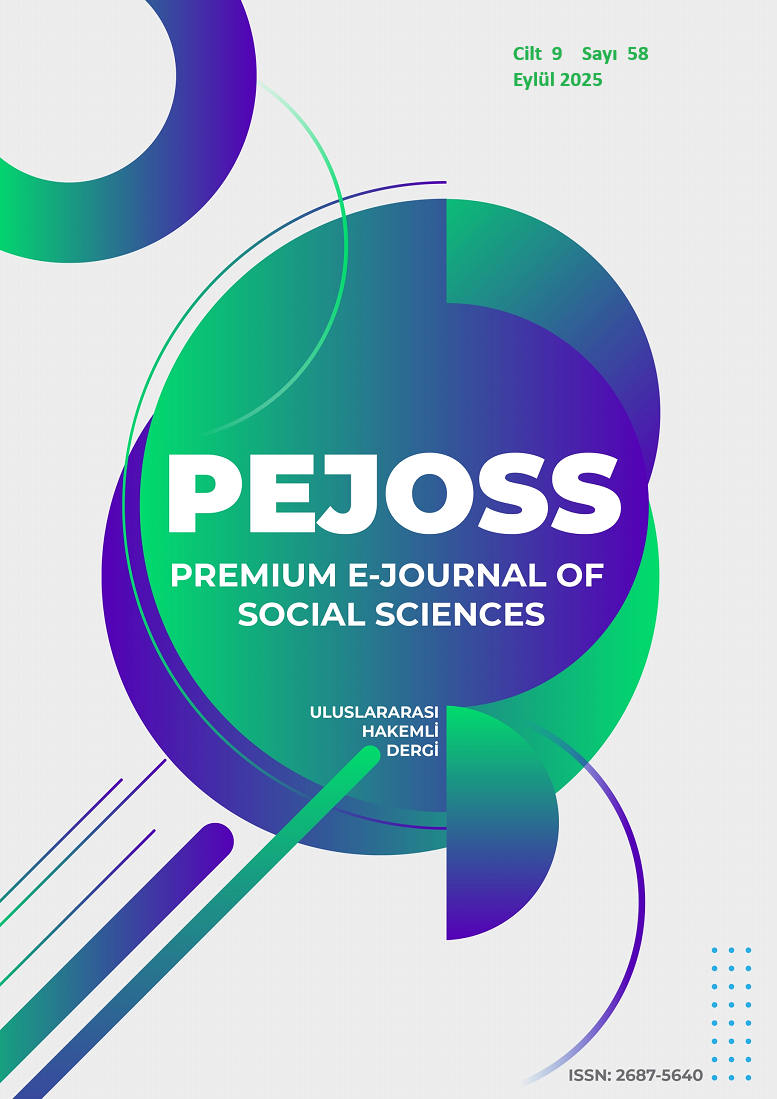The Visual Texture of Cities: Typographic Traces and Rhythmic Surfaces
DOI:
https://doi.org/10.5281/zenodo.17234028Keywords:
Urban Identity, Visual Texture, Typography, Graphic Design, Visual Communication.Abstract
Cities acquire identity through their architectural structures, cultural symbols, and typographic traces inscribed on urban surfaces. Typographies located within urban spaces make cultural memory, a sense of belonging, and diversity visible alongside the visual texture. Historical layers convey traces of the past into the present, becoming a visual component of cultural memory. In this context, typography is considered not only as a form of written expression but also as a visual language that strengthens urban memory, reinforces individuals’ connection with the city, and reflects the spirit of the place. Typographic practices on urban surfaces contribute to recognizing this richness and raising awareness. This study is based on the descriptive analysis approach, one of the qualitative research methods. As a result of examinations conducted in national and international cities, typographic elements that affect the visual texture are scrutinized. By addressing aesthetic and cultural dimensions together, spatial typographic practices, weathered signs, and incidental typographic examples are analyzed in the context of rhythmic surfaces. These analyses are carried out in line with criteria such as visual impact, spatial-surface relations, rhythm, color, and typography, and the relationship between urban identity and cultural texture is emphasized. Thus, typography emerges as an element that removes daily life from ordinariness and reinforces collective memory. The evaluation of typographic elements that leave traces on urban surfaces in terms of rhythm and surface relations renders the visual memory of urban identity visible. In this regard, the research offers a different perspective on the relationship between typography and the city. Consequently, urban typography is revealed as a significant means of visual communication that carries the unique signature of a city.
Downloads
References
Akdağ Satır, D. (2023). Tarihi kent dokusunun korunmasında grafik tasarımın rolü. İdil, 105 (2023 Mayıs): s. 673–682. Doi: 10.7816/idil-12-105-10
Ambrose, G. & Harris, P. (2013). Yaratıcı tasarımın temelleri. Literatür.
Ambrose, G. & Harris, P. (2017). Görsel tipografi sözlüğü. Literatür.
Aşçı, S., & Uyan, Ö. (2025). Kent kimliğinin görsel ifadesinde logonun reri: Çanakkale Belediyesi örneği. Uluslararası Sosyal Bilimler Akademik Araştırmalar Dergisi, 8(2), 51-59.
Berger, C. (2014). Typography, placemaking and signs: Part I – The history of typography and place (SFI White Paper Series). Signage Foundation, Inc.
Bilgin, N. (2011). Sosyal düşüncede kent kimliği. İdealkent, (3), 20-47.
Boğ, K. E. E. (2019). Şehir kimliği ve yazı karakteri ilişkisi. Dumlupınar Üniversitesi Sosyal Bilimler Dergisi, 61, 109–121. https://doi.org/10.46237/dpusbe.2019.61
Calori, C., & Vanden-Eynden, D. (2015). Signage and wayfinding design: A complete guide to creating environmental graphic design systems (2nd ed.). John Wiley & Sons.
Craveiro, R. (2017). The influence of graffiti writing in contemporary typography. SAUC-Street Art and Urban Creativity (repository), 3(2), 65-83. https://doi.org/10.25765/sauc.v3i2.82
CrossMagri. (2025). This is why street art is an important part of cities’ identity. https://crossmagri.com/this-is-why-street-art-is-an-important-part-of-cities-identity/
Design Shifu. (2025). Graffiti with words: Revolutionizing street art with typography. https://designshifu.com/graffiti-with-words-revolutionizing-street-art-with-typography/?utm_
Ertürk, M. (2019). Görsel iletişim tasarımında bir tasarım yaklaşımı olarak vernaküler. Sanat Dergisi, (34), 174-182.
Gezgin, S. & İralı, A. E. (2017). Modern ortamda kültürel kimliğin sayısal yansımaları. İletişim ve Kültür. Ed: Suat Gezgin ve Tuğba Akdal. Eğitim Yayınevi.
Heller, S. & Anderson, G. (2023). Tipografi fikirler kitabı. Ketebe.
Ho, A., & Chau, R. (2025). The influence of culture on typeface perception and design. In Human Interaction and Emerging Technologies (IHIET 2025) (Vol. 197, pp. 518–528). AHFE International. DOI: 10.54941/ahfe1006745
Kayabaş, T. D., & Sayın, Z. (2022). Grafik tasarım bağlamında kent kimliğinde bilgilendirme ve yönlendirme grafiklerinin önemi. Art-E Sanat Dergisi, 15(30), 1403-1429. https://doi.org/10.21602/sduarte.1183096
Kumar, R., Yadav, D., Dhar, D., & Urala, G. H. G. (2025). Typography in urban and built environment: Influence on human perception. Civil Engineering and Architecture, 13(3A), 2769-2782. https://doi.org/10.13189/cea.2025.131341
Lynch, K. (1959). The Image of the City. Cambridge, MA: The MIT Press.
Nakagawa, C. (2018). The interaction between typography and architecture in Amsterdam. https://medium.com/@corinnenakagawa/the-interaction-between-typography-and-architecture-in-amsterdam-7af6c99dc6d6
Pilici, E. (2019). Kent kimliğinin kurumsallaşması ve markalaşması. Uluslararası Disiplinlerarası ve Kültürlerarası Sanat, 4(9), 95-107.
Sarıkavak, N. K. (2014). Kaligrafik ve tipografik deneysel tasarımlar. Grafik Kitaplığı.
Sugita, M. (2019). Urban typography: A glimpse into a world of local typefaces in Japanese cities, and their survival. https://worldarchitecture.org/architecture-news/eczge/urban-typography-a-glimpse-into-a-world-of-local-typefaces-in-japanese-cities-and-their-survival.html
Şengel, Ş. (2019). Mimaride tipografik unsurlar ve kent estetiğine etkisi. Dumlupınar Üniversitesi Sosyal Bilimler Dergisi, Özel Sayı, 119-134.
Type. (2022). Typography’s lost place in architecture. https://www.type.ie/blog/typographys-lost-place-in-architecture
Uçar, T. F. (2004). Görsel iletişim ve grafik tasarım. İnkılap Kitabevi.
Villagomez, N. (2015). Culture + typography: How culture affects typography. HOW Books.
Werlik. (2024). Helsinki: Branding the most functional city in the world. https://werklig.com/success-stories/helsinki-branding-the-most-functional-city-in-the-world
GÖRSEL KAYNAKLAR
Type. (2022). Typography’s lost place in architecture. https://www.type.ie/blog/typographys-lost-place-in-architecture
Concorde (2022). Add these 5 famous paintings of the MoMA to your must-See list. https://www.concordehotelnewyork.com/blog/add-these-5-famous-paintings-of-the-moma-to-your-must-see-list
MoMA. (2025). MoMA PS1. https://www.moma.org/
Medium. (2018). The interaction between typography and architecture in Amsterdam. https://medium.com/@corinnenakagawa/the-interaction-between-typography-and-architecture-in-amsterdam-7af6c99dc6d6
Pentagram. (n.d.). New Jersey Performing Arts Center. https://www.pentagram.com/work/new-jersey-performing-arts-center
The Guardian. (2015). Your favourite city fonts-in pictures. https://www.theguardian.com/cities/ 2015/jan/29/your-favourite-city-fonts-in-pictures
Downloads
Published
How to Cite
Issue
Section
License
Copyright (c) 2025 Premium e-Journal of Social Science (PEJOSS)

This work is licensed under a Creative Commons Attribution 4.0 International License.


